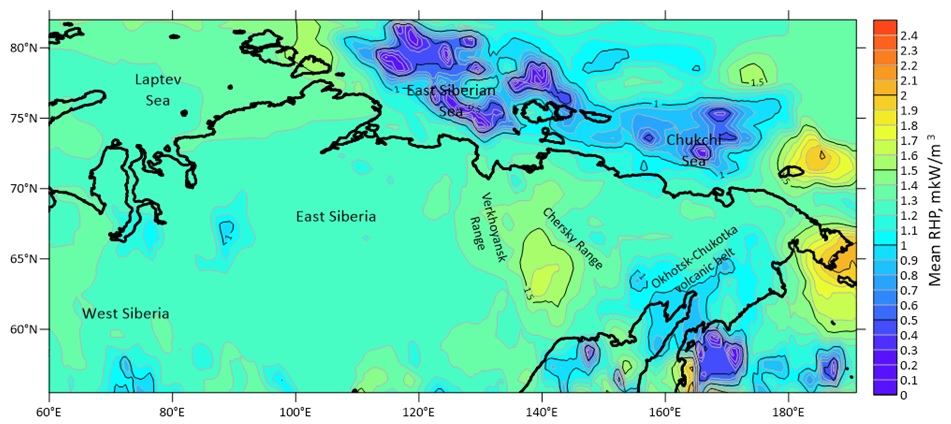Data on the average value of effective radiogenic heat generation in the upper crust
(Figure 1) have been obtained for the Russian Arctic zone,
Siberia and the Far East. The model resolution is no worse than 110 km. The calculations used
new models for the sedimentary cover [Sidorov et al., 2021] and
the depth of the Moho boundary [Kaban et al., 2022].
The greatest contribution to effective heat generation in the upper part of the Earth's
crust is the thermal energy released by radioactive elements characterized by the longest
half-lives. First of all, these are uranium-235 (235U) and uranium-238 (238U),
as well as thorium-232 (232Th) and potassium-40 (40K).
The map gives an idea of areas with a high content of radioactive elements in the upper
crust or areas in which the removal of radioactive elements into the lithosphere from the mantle
may occur. This includes, for example, the area of the rift zone separating the Siberian platform
from the Verkhoyansk-Chukchi fold system (Chersky Ridge), as well as extensive thermal anomalies
in the Bering and Chukchi Seas.
The data has the following designation: MeanRHP.dat
Data format description - MeanRHP_format.pdf.

Mean radiogenic heat production in the upper part of the lithosphere
References
Sidorov R.V., Kaban M.K., Soloviev A.A., Petrunin A.G., Gvishiani A.D., Oshchenko A.A., Popov A.B.,
& Krasnoperov R.I.
Sedimentary basins of the eastern Asia Arctic zone: new details on their structure revealed by decompensative gravity anomalies.
Solid Earth. 2021. Vol. 12. No. 12. P. 2773-2788. https://doi.org/10.5194/se-12-2773-2021
Kaban M.K., Sidorov R.V., Soloviev A.A., Gvishiani A.D., Petrunin A.G., Petrov O.V., Kashubin S., Androsov E.A., & Milshtein E.D.
A new Moho map for North-Eastern Eurasia based on the analysis of various geophysical data.
Pure and Applied Geophysics. 2022. Vol. 179. No. 11. P. 3903-3916. https://doi.org/10.1007/s00024-021-02925-6

